A Brother’s Gift Helps Young Boy Beat Cancer Twice with Help from Holtz Children’s Hospital
A Brother’s Gift Helps Young Boy Beat Cancer Twice with Help from Holtz Children’s Hospital
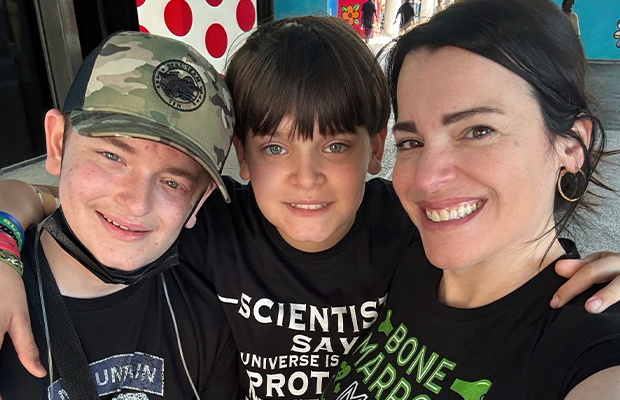
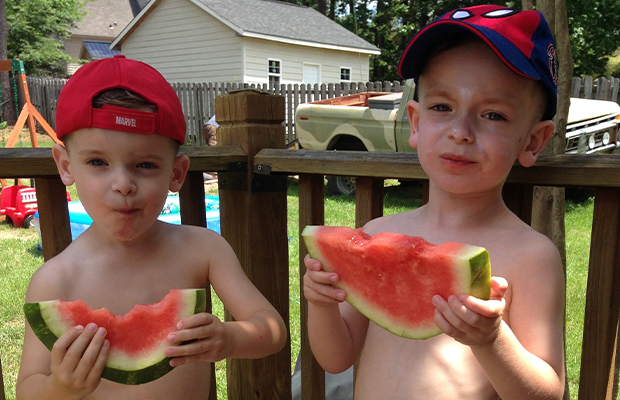
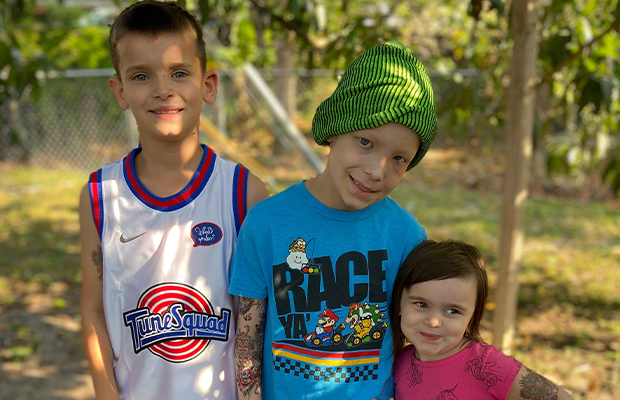
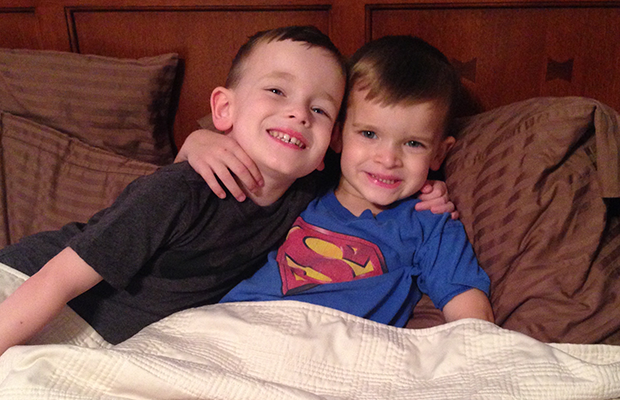
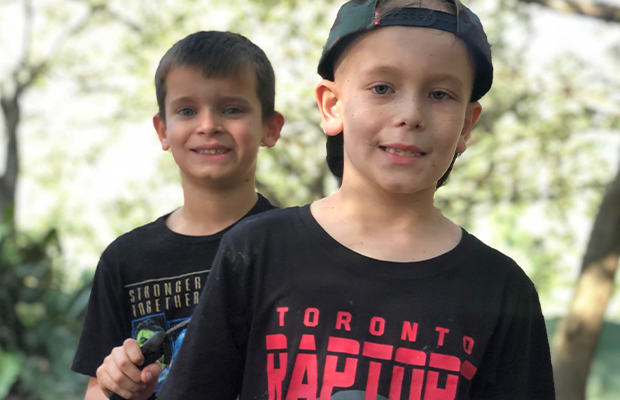
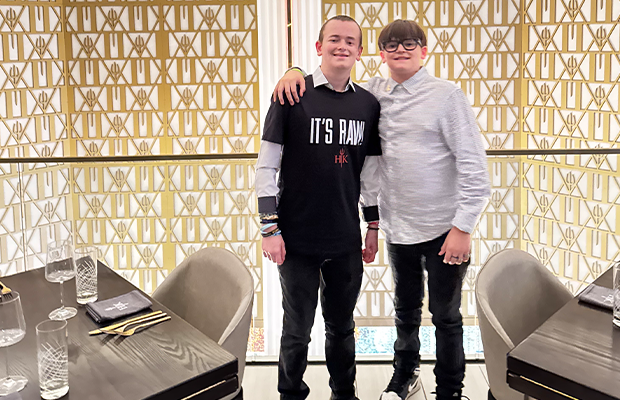
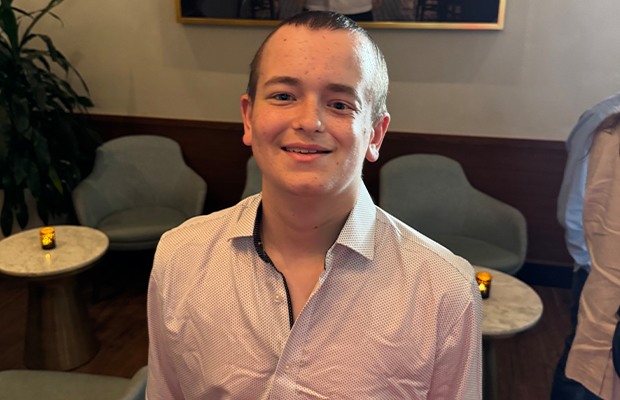
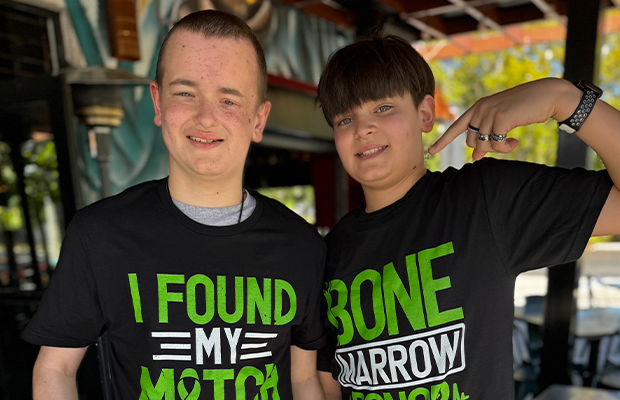
By: Krysten Brenlla
At just 14, Jake Alexander Kleppen is known on Instagram as a “victorious warrior” – a title he’s earned by facing cancer not once, but twice.
“I never felt any symptoms – all we noticed was my eye,” he said. “It was swelling a lot, and I was originally diagnosed with hypertropia when I was 8.”
Hypertropia is a condition where one eye turns upward. But when Jake’s pediatrician took a closer look, she noticed something was off. She sent him to the emergency room for testing, where doctors made a life-changing discovery.
“He was actually suffering from Ewing sarcoma,” said Marisel Jarrin Kleppen, Jake’s mother. “Never did I imagine we would leave the hospital with a cancer diagnosis.”
Ewing sarcoma is an aggressive soft tissue cancer that usually appears in the limbs, hips, or chest. For Jake, it appeared in his eye, which is extremely rare.
“At that point, he was already stage three,” Marisel said. “Had we waited any longer, who knows what would’ve happened.”
Thankfully, in September 2019, Jake found a specialized pediatric cancer team at Holtz Children’s Hospital.
“We targeted his cancer with 11 months of chemotherapy and 31 rounds of proton beam radiation, which is very precise,” Marisel said. “It affected the symmetry of his face, vision, teeth, and even cognition. But still, he fights through that – he’s super smart and never gives up.”
Eventually, Jake rang the bell at Holtz Children’s – he was cancer-free. He returned home to his family and friends, celebrating nearly five years of remission.
“I felt so free – I felt amazing,” Jake said.
But toward the end of 2024, after a week at Civil Air Patrol camp, Jake felt sick.
“I gave him Advil, and told him to go to sleep. The next morning, he woke up in a puddle of sweat,” Marisel said. “I knew immediately that we had to go to the hospital.”
In December, Jake was diagnosed with his second form of cancer – leukemia, a blood and bone marrow cancer where abnormal white blood cells crowd out the healthy ones, making it hard for the body to fight infections, stop bleeding, or carry oxygen.
“They did the blood test, and they noticed that his white blood cells were basically non-existent,” Marisel said. “All his numbers were low, and in my head, I didn’t want to think it was cancer. But I just knew it wasn’t normal.”
Jake was referred back to Holtz Children’s to fight cancer a second time.
“Unfortunately, the leukemia was caused by the treatments he received to fight off his original cancer,” said David Crawford, MD, director of pediatric stem cell transplantation at Holtz Children’s and UHealth – University of Miami Health System. “But Jake will be a unique child who survives two different malignancies.”
His new treatment plan included chemotherapy and a targeted drug called blinatumomab, which uses the body’s immune system to attack leukemia cells, in hopes of reaching remission.
Once Jake was in remission, the search for a bone marrow donor began – and against all odds, his brother, Justin, was a perfect match.
“The first time Jake was diagnosed with cancer, I was devastated,” Justin said. “I couldn’t believe he had to go through this a second time, but I knew I had to stay strong. When I found out I was a match to be his bone marrow donor, I was so excited.”
On May 12, 2025, after months of preparation that included immunotherapy, chemotherapy, and full-body radiation, Jake was ready for his bone marrow transplant.
“Being Jake’s donor is going to give us a bigger and better bond, and I’m just excited for him to get better afterward,” Justin said.
“Having Justin as my donor means we’re really blood bonded now,” Jake said. “I’m so grateful.”
Within six weeks, Jake’s team hopes he’ll be able to go home. And within a year, they’re optimistic he’ll fully recover with a new immune system from his brother.
“At Holtz Children’s, we have outstanding pediatric cancer care and cutting-edge treatment options,” Dr. Crawford said. “Jake and his family are wonderful people – we’re hopeful that he’ll survive this and feel like himself again.”
“I tell other kids who may be going through something similar to always see the good in everything,” Jake said. “It’s not going to be easy, but always try to find the silver lining, and you’ll be okay. I know I will.”
Fifteen Years and Counting: How a Kidney Transplant from the Miami Transplant Institute Saved Young Boy’s Life
Fifteen Years and Counting: How a Kidney Transplant from the Miami Transplant Institute Saved Young Boy’s Life
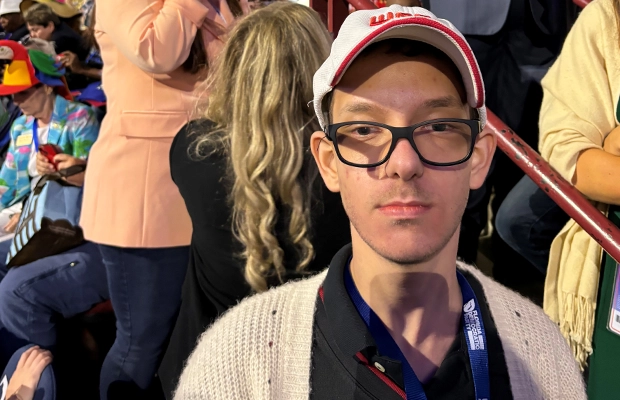
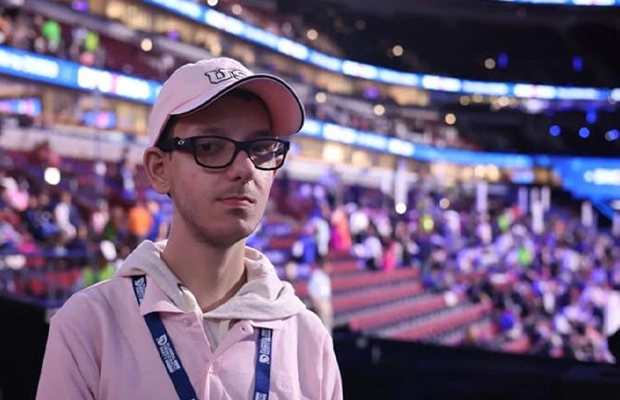
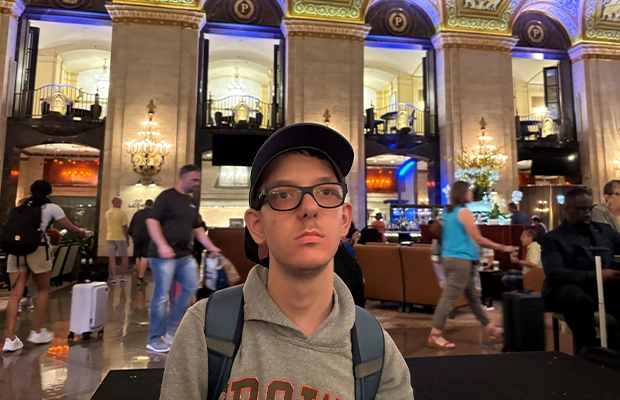
By: Krysten Brenlla
When Chase Cooper, 20, was just 2 years old, he was diagnosed with a congenital kidney and urinary tract condition. One of his kidneys was filled with cysts – a condition called multicystic dysplastic kidney.
Additionally, the other kidney had a blockage where the ureter, a thin tube that carries urine from each kidney to the bladder, didn’t develop normally.
“My family knew from the minute I was born that I would have problems with my kidneys,” Cooper said. “They knew that I’d eventually need a transplant.”
To find the best treatment options, his family sought care at the Miami Transplant Institute (MTI), an affiliation between Jackson Health System and UHealth – University of Miami Health System.
After an extensive evaluation, the multidisciplinary team found that Cooper was eligible for a kidney transplant, and he was placed on the list.
For 10 months, he received at-home peritoneal dialysis. However, on a Wednesday evening in 2010, Cooper’s family got the call they longed for – there was a match.
Five-year-old Cooper and his loved ones rushed to Jackson Memorial Hospital, where he underwent his kidney transplant, performed by Gaetano Ciancio, MD, chief medical officer and director of the kidney and kidney-pancreas transplant programs at MTI.
The surgery marked the beginning of a new chapter, but it was far from the end of Cooper’s medical journey.
“Even if someone has a healthy kidney after transplant, the medical process doesn’t stop,” he said. “Taking care of it is one thing, but sustaining it for 15 to 20 years is the real challenge.”
However, despite the obstacles throughout his life, the team at MTI has been Cooper’s guiding force.
“Chase’s case is remarkable – many pediatric transplant recipients require multiple transplants over the years, yet Chase’s kidney has lasted an impressive 15 years,” said Marissa Defreitas, MD, a pediatric nephrologist at MTI. “However, the challenges extend beyond the kidney itself. As a side effect of the anti-rejection medications, Chase developed diabetes, along with gastrointestinal complications.
Despite these hurdles, he continues to push forward with the unwavering support of his family and the team at Jackson and MTI.”
As he grew older, Cooper began to advocate about the urgent need for organ donors, speaking at school events and debate tournaments. Throughout his kidney transplant journey, he also developed a passion for encouraging young people to register as organ donors.
“I think every day about the people on the transplant list who need an organ – just like I needed a kidney,” Cooper said. “It’s a tremendous gift – I wouldn’t know where I’d be if I didn’t get that kidney. That’s what Jackson does best – they give people another opportunity to live life to the fullest.”
Now a political science major at Lynn University, Cooper’s committed to making a difference. He hopes to continue advocating for organ donation through community efforts and speaking engagements.
“During Donate Life Month in April, I tell people – check the box. You can save eight lives in one day,” Cooper said. “We need more people who are willing to donate because too many people are waiting for their second chance.”
Woman Regains Mobility After Parkinson’s Diagnosis Through Specialized Therapy at Jackson North
Woman Regains Mobility After Parkinson’s Diagnosis Through Specialized Therapy at Jackson North
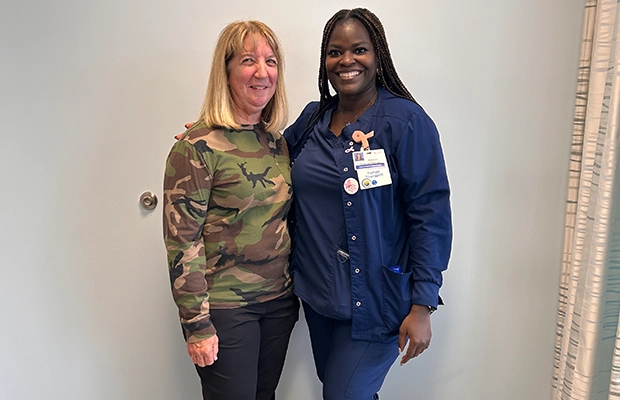
By: Krysten Brenlla
Sandra Senkow has always embraced an active lifestyle – she loves the outdoors, riding bikes, and spending time with her family.
Two years ago, Senkow’s life took an unexpected turn when she began experiencing symptoms that would later lead to a Parkinson’s disease diagnosis.
“It all started after knee surgery when my boyfriend noticed subtle changes in my movements,” Senkow said.
With a family history of Parkinson’s, the 59-year-old was concerned. She sought medical advice, undergoing a series of tests before receiving a definitive diagnosis.
The news was a shock, but Senkow was determined to face the challenge head-on.
“My symptoms primarily affected my walking,” she said. “My aunt had Parkinson’s disease, so when I got the diagnosis, I knew I needed to be proactive to manage the condition.”
With the help of her family, Senkow explored various treatment options, including Lee Silverman Voice Treatment (LSVT), a specialized, high-intensity program designed to help people with Parkinson’s improve their movement and speech by retraining the brain with specific repetitive exercises.
After some research, her family found the LSVT program at Jackson North Medical Center, where she met her physical therapist, Sabrina Cherelus.
“When I first saw Sandra, she exhibited common Parkinson’s symptoms, including rigidity, slowed movement, and walking impairments, like uneven steps,” Cherelus said. “Although she hadn’t experienced falls, she was still a fall risk. That’s when we decided LSVT BIG would be a great intervention for her.”
LSVT BIG is a program designed to help patients with Parkinson’s and other neurological conditions regain movement control. Over the course of four weeks— four sessions per week— Senkow worked with physical therapists on different exercises, which incorporated seven daily exercises that were tailored to her needs.
“The LSVT BIG exercises are designed to retrain the brain and create new pathways to compensate for Parkinson’s-related impairments,” Cherelus said. “Sandra was incredibly consistent and motivated. She kept up with her home exercises and always came in ready to show her progress.”
By the end of her therapy, Senkow had achieved measurable results. She transitioned from a medium fall risk to a low fall risk, regained her natural walking ability, and returned to walking four to five miles regularly.
“It was night and day from when she started,” Cherelus said. “She not only met her goals, but also gained a tool to manage her symptoms. Parkinson’s is a lifelong condition, but with science, technology, and therapy, we can help patients maintain their mobility and independence for longer.”
“I want to keep Parkinson’s at bay as long as I can by staying active and using the techniques they taught me,” Senkow added. “The therapy was fantastic, and Sabrina was great. I’d tell anyone with Parkinson’s to sign up for LSVT—it makes a real difference.”
Man Diagnosed with Rare Autoimmune Disease Beats the Odds with Life-Saving Lung Transplant at Miami Transplant Institute
Man Diagnosed with Rare Autoimmune Disease Beats the Odds with Life-Saving Lung Transplant at Miami Transplant Institute
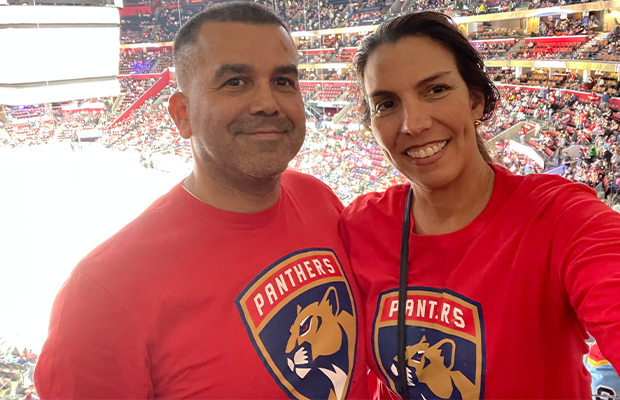
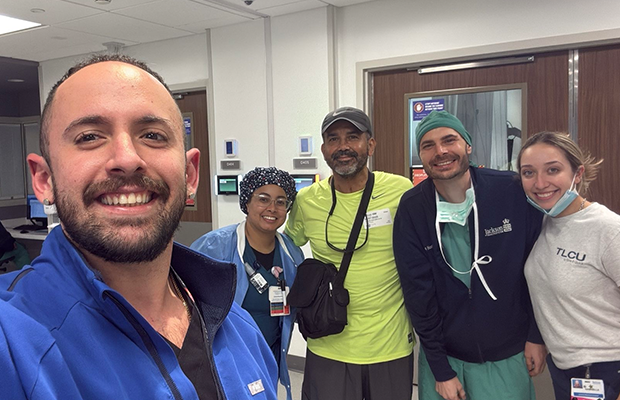
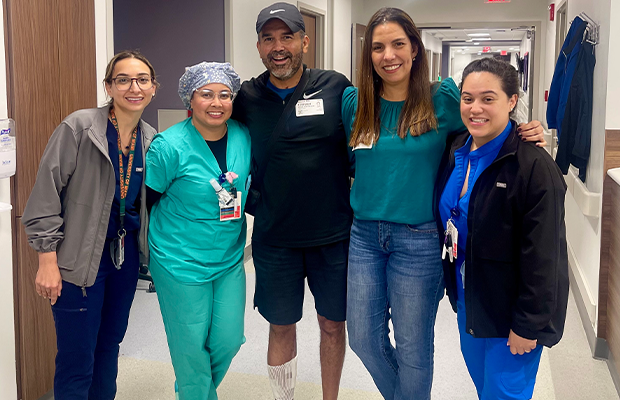
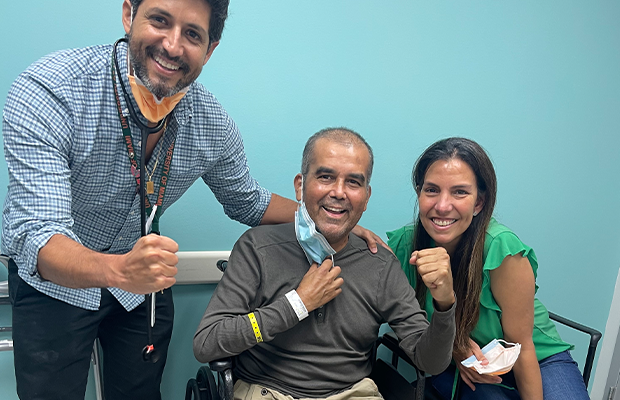
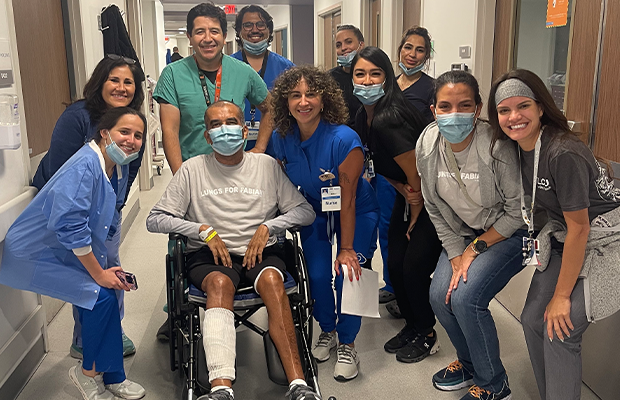
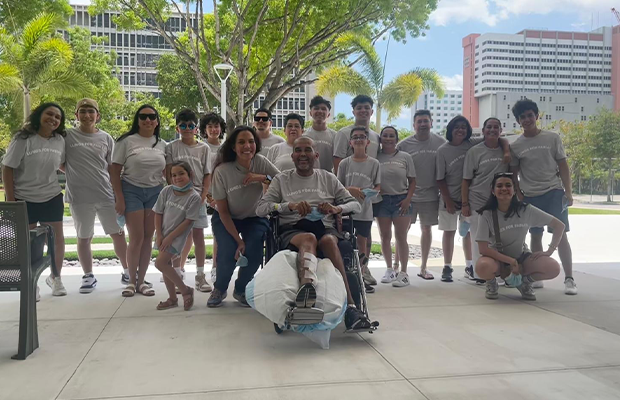
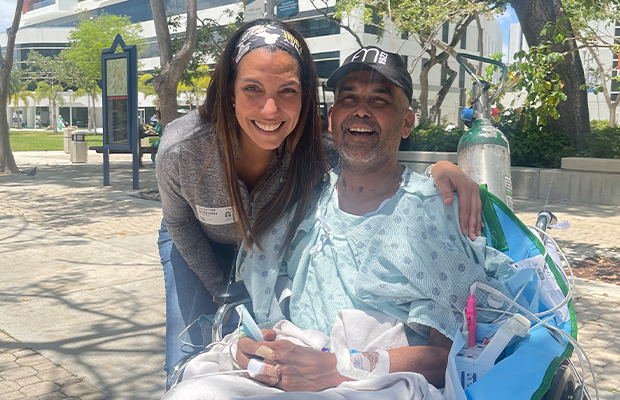
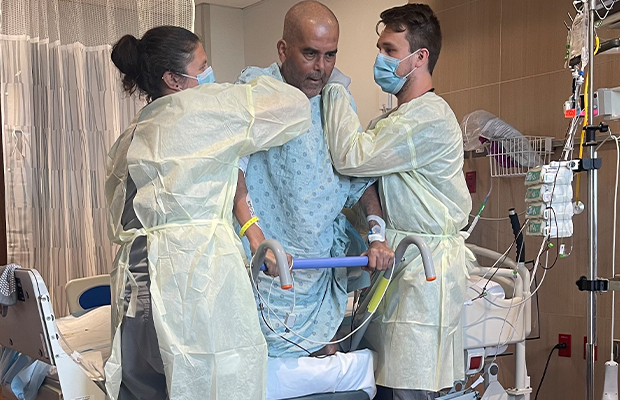
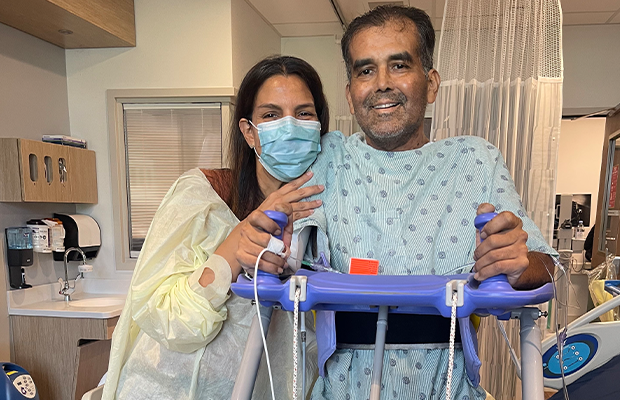
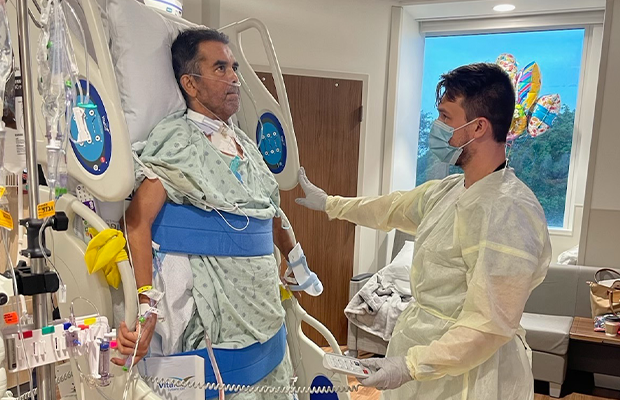
By: Miranda Torres
“You probably will never have children”, are words Richardy Blanchard, 40, heard in her early 20’s after being diagnosed with polycystic ovarian syndrome. After two decades of irregular menstrual cycles, she was shocked to discover she was pregnant.
Due to her diagnosis and age, Blanchard began seeing a high-risk maternal fetal medicine doctor along with her OB-GYN to create a prenatal care plan. During a routine check-up at 18 weeks, the ultrasound tech discovered Blanchard had an incompetent cervix, meaning her cervix was too short to support a pregnancy.
The doctor told Blanchard, “This is an inevitable abortion and you’ll be lucky if he survives another week. But we’ll catch it next time for your next pregnancy.”
“He didn’t know everything it took for me to get to this point to be a mom,” Blanchard said. “It was so dismissive.”
Blanchard sought a second opinion and found The Women’s Hospital at Jackson Memorial. After reading a patient testimonial about a mother who gave birth to two healthy babies after having a cervical cerclage, or procedure to help keep the cervix closed, she knew The Women’s Hospital team would be equipped to care for her and her baby.
At 19 weeks, Blanchard began having unusual discharge and visited the emergency room at Jackson Memorial Hospital. The doctor explained that because of her open cervix, her amniotic sack was protruding, posing a risk for sepsis, a potentially lethal reaction to an infection that can lead to organ failure. The options included inducing labor, which would mean the baby would be stillborn, or leaving the hospital because her pregnancy was not yet viable. It was then she met Devita Price, APRN, director of professional practice at The Women’s Hospital.
“As a healthcare professional, I empowered her to listen to her gut and her body and reminded her we are here to help along the way and keep her educated on ALL her options,” Price said.
Blanchard decided to go home and trust that God would make a way for her to have this baby.
During her ER visit, Blanchard also met Pouya Abhari, MD, FACOG, a maternal fetal medicine specialist at The Women’s Hospital. Dr. Abhari promised that once Blanchard reached 22 weeks gestation, the earliest stage of viability for a baby, he would admit her and care for her until it was time to deliver her baby.
Once she was admitted at 22 weeks, Blanchard’s cervix was already 3 centimeters dilated.
The high-risk team was monitoring her and her baby daily for signs of preterm labor and infection.
Additionally, a counsellor was brought in several times to speak with Blanchard and address her mental wellbeing. Maternal mental health is a priority at Jackson, especially among Dr. Abhari’s team at The Women’s Hospital.
“We want mothers to feel like they are still being focused on and taken care of as a person, outside of being an expectant mom,” Dr. Abhari said.
At 30 weeks, Blanchard’s water broke and she went into labor naturally. The Holtz Children’s Hospital NICU team was present during the labor to ensure her baby would receive the necessary care from the moment he entered the world.
“The synergy between the delivery and NICU team was something I had never seen before. It was perfect, I couldn’t have dreamed of a more perfect birth,” Blanchard said.
Samuel Gerdes was born healthy, answering all of Blanchard’s prayers.
“When I held my son, I felt God was with me,” she said. “I was holding him while he was crying, and I felt so grateful for the gift of being a mom.”
While in the NICU, Samuel never required oxygen and took to bottle feeding quickly with donor milk, allowing him to gain weight and reach his milestones. Blanchard spent every available moment by his side.
“Being a first-time parent and this being her miracle baby, she was a great advocate and had thoughtful questions,” said Rebecca Jones, MD, a NICU hospitalist at Holtz Children’s. “For us it’s something we do every day but for these parents, it’s something they experience just one in their lifetime, so it’s important for us to give them time and space to take it all in and answer all their questions.”
Two months later, Samuel was discharged, finally going home to be surrounded by his family.
“Throughout this journey, I have experienced the best and worst of the healthcare industry,” Blanchard said. “Thank you to every doctor who answered my questions, celebrated every day with me, learned my son’s name, and embodied God’s love.”
Defying the Diagnosis: A Journey to First-time Motherhood at The Women’s Hospital at Jackson Memorial
Defying the Diagnosis: A Journey to First-time Motherhood at The Women’s Hospital at Jackson Memorial
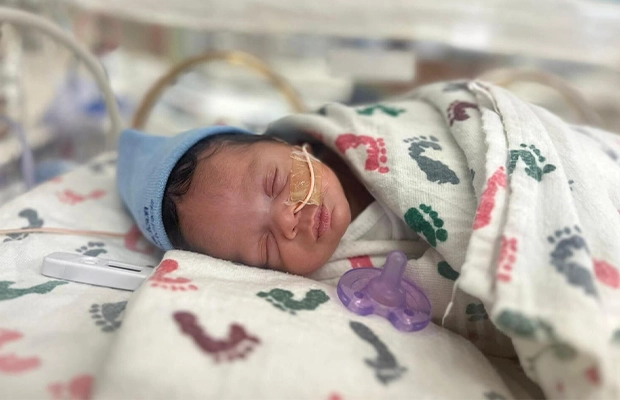
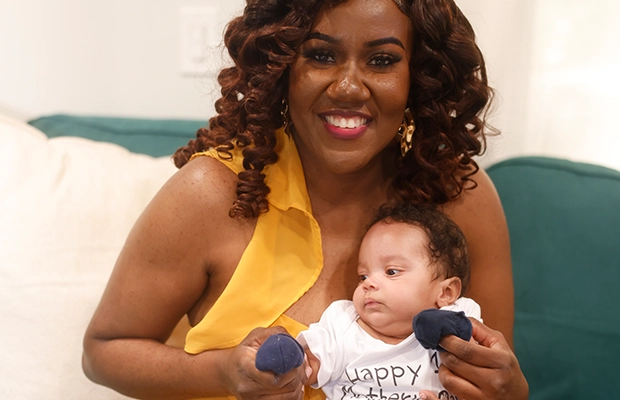
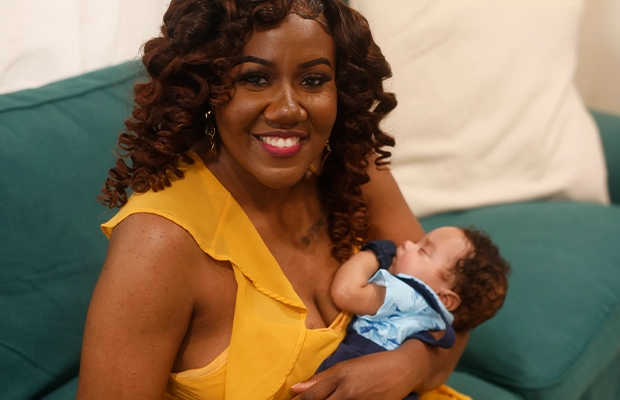
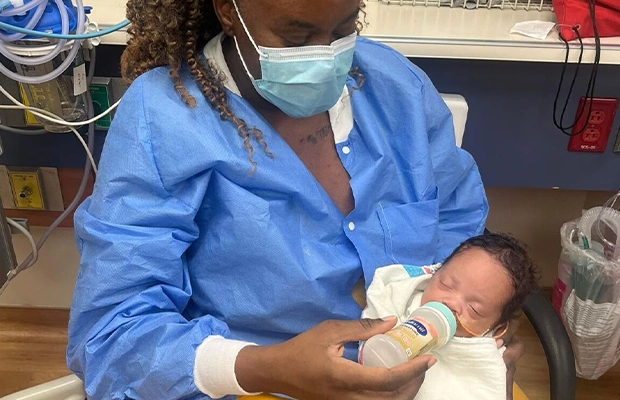
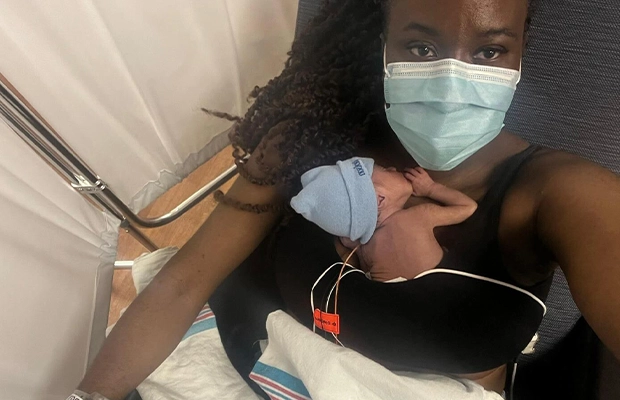
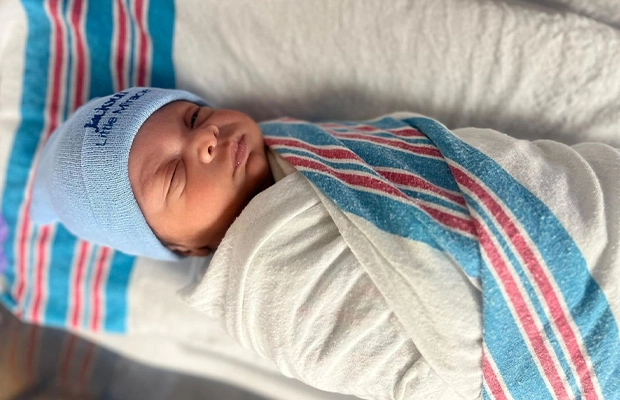
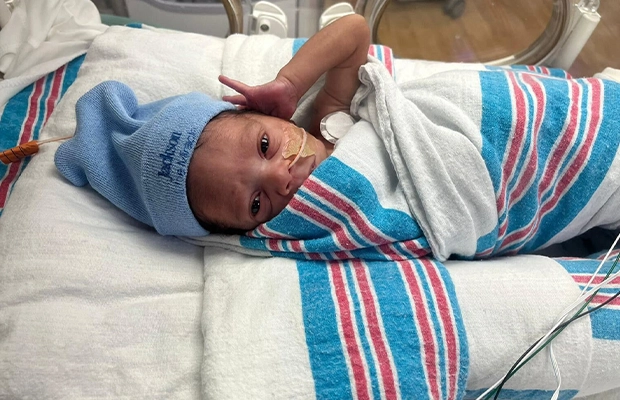
By: Miranda Torres
“You probably will never have children”, are words Richardy Blanchard, 40, heard in her early 20’s after being diagnosed with polycystic ovarian syndrome. After two decades of irregular menstrual cycles, she was shocked to discover she was pregnant.
Due to her diagnosis and age, Blanchard began seeing a high-risk maternal fetal medicine doctor along with her OB-GYN to create a prenatal care plan. During a routine check-up at 18 weeks, the ultrasound tech discovered Blanchard had an incompetent cervix, meaning her cervix was too short to support a pregnancy.
The doctor told Blanchard, “This is an inevitable abortion and you’ll be lucky if he survives another week. But we’ll catch it next time for your next pregnancy.”
“He didn’t know everything it took for me to get to this point to be a mom,” Blanchard said. “It was so dismissive.”
Blanchard sought a second opinion and found The Women’s Hospital at Jackson Memorial. After reading a patient testimonial about a mother who gave birth to two healthy babies after having a cervical cerclage, or procedure to help keep the cervix closed, she knew The Women’s Hospital team would be equipped to care for her and her baby.
At 19 weeks, Blanchard began having unusual discharge and visited the emergency room at Jackson Memorial Hospital. The doctor explained that because of her open cervix, her amniotic sack was protruding, posing a risk for sepsis, a potentially lethal reaction to an infection that can lead to organ failure. The options included inducing labor, which would mean the baby would be stillborn, or leaving the hospital because her pregnancy was not yet viable. It was then she met Devita Price, APRN, director of professional practice at The Women’s Hospital.
“As a healthcare professional, I empowered her to listen to her gut and her body and reminded her we are here to help along the way and keep her educated on ALL her options,” Price said.
Blanchard decided to go home and trust that God would make a way for her to have this baby.
During her ER visit, Blanchard also met Pouya Abhari, MD, FACOG, a maternal fetal medicine specialist at The Women’s Hospital. Dr. Abhari promised that once Blanchard reached 22 weeks gestation, the earliest stage of viability for a baby, he would admit her and care for her until it was time to deliver her baby.
Once she was admitted at 22 weeks, Blanchard’s cervix was already 3 centimeters dilated.
The high-risk team was monitoring her and her baby daily for signs of preterm labor and infection.
Additionally, a counsellor was brought in several times to speak with Blanchard and address her mental wellbeing. Maternal mental health is a priority at Jackson, especially among Dr. Abhari’s team at The Women’s Hospital.
“We want mothers to feel like they are still being focused on and taken care of as a person, outside of being an expectant mom,” Dr. Abhari said.
At 30 weeks, Blanchard’s water broke and she went into labor naturally. The Holtz Children’s Hospital NICU team was present during the labor to ensure her baby would receive the necessary care from the moment he entered the world.
“The synergy between the delivery and NICU team was something I had never seen before. It was perfect, I couldn’t have dreamed of a more perfect birth,” Blanchard said.
Samuel Gerdes was born healthy, answering all of Blanchard’s prayers.
“When I held my son, I felt God was with me,” she said. “I was holding him while he was crying, and I felt so grateful for the gift of being a mom.”
While in the NICU, Samuel never required oxygen and took to bottle feeding quickly with donor milk, allowing him to gain weight and reach his milestones. Blanchard spent every available moment by his side.
“Being a first-time parent and this being her miracle baby, she was a great advocate and had thoughtful questions,” said Rebecca Jones, MD, a NICU hospitalist at Holtz Children’s. “For us it’s something we do every day but for these parents, it’s something they experience just one in their lifetime, so it’s important for us to give them time and space to take it all in and answer all their questions.”
Two months later, Samuel was discharged, finally going home to be surrounded by his family.
“Throughout this journey, I have experienced the best and worst of the healthcare industry,” Blanchard said. “Thank you to every doctor who answered my questions, celebrated every day with me, learned my son’s name, and embodied God’s love.”
Pediatric Transplant Team Give Central Florida Teenager a Second Chance at Life at Holtz Children’s Hospital
Pediatric Transplant Team Give Central Florida Teenager a Second Chance at Life at Holtz Children’s Hospital
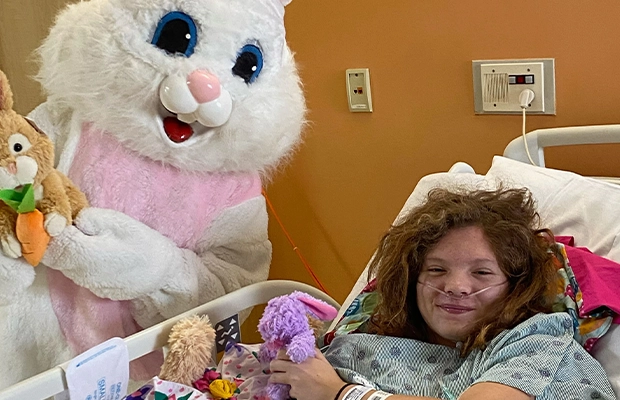
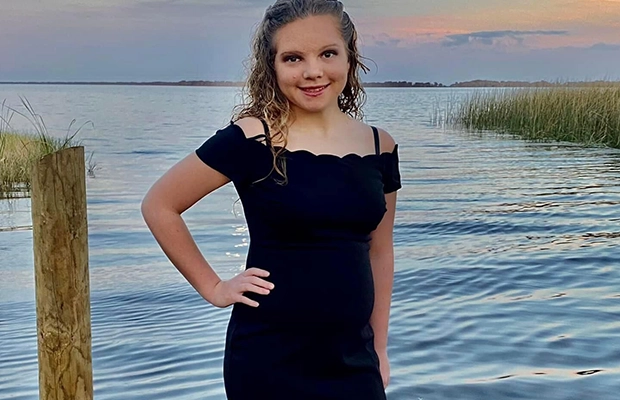
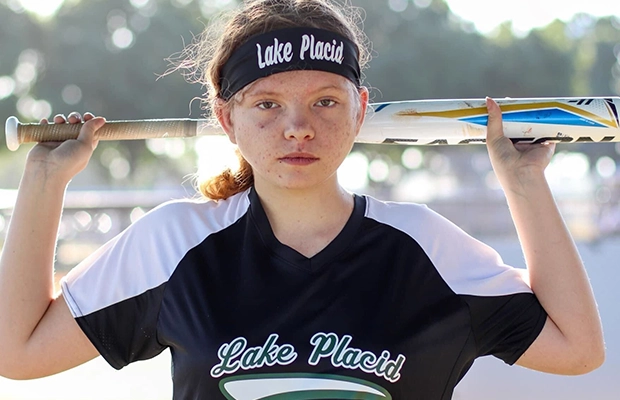
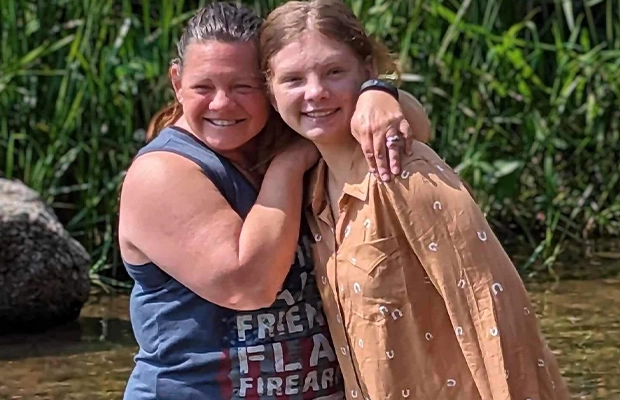
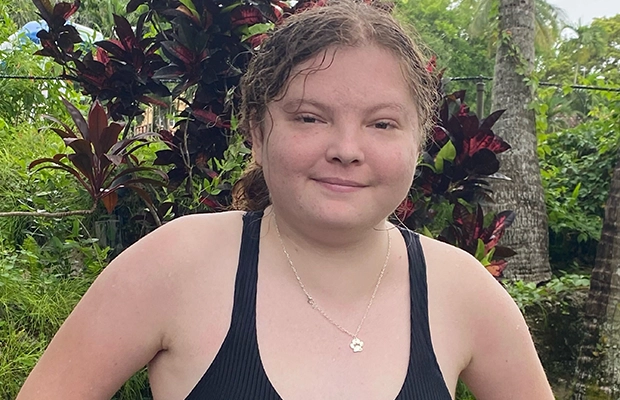
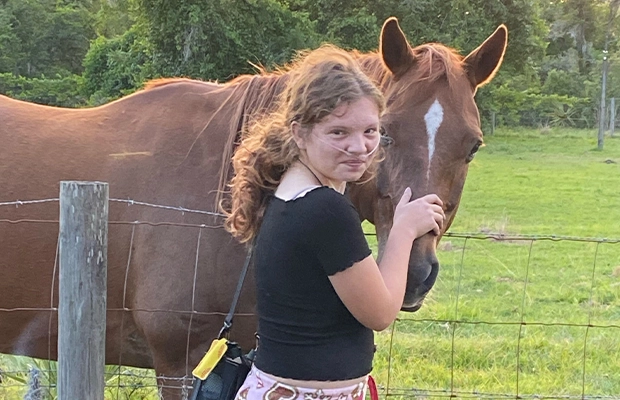
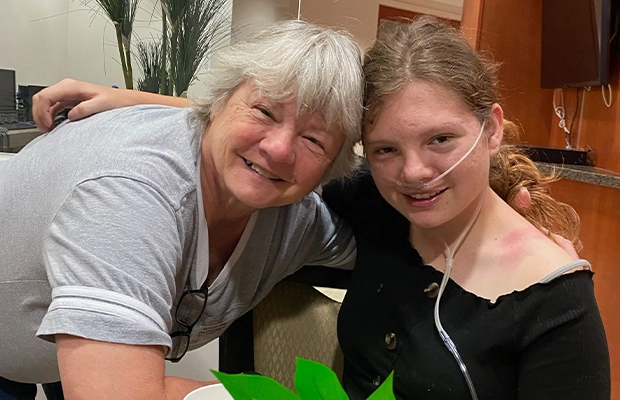
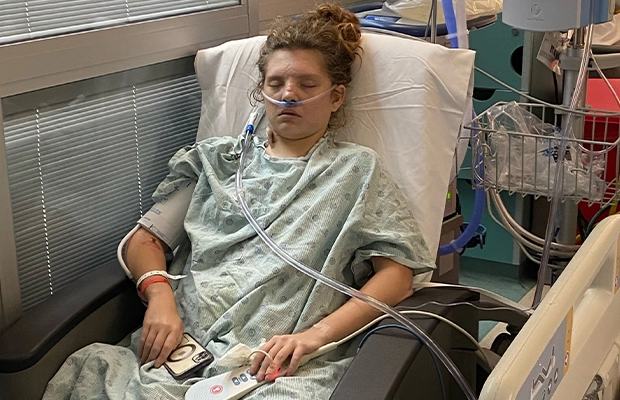
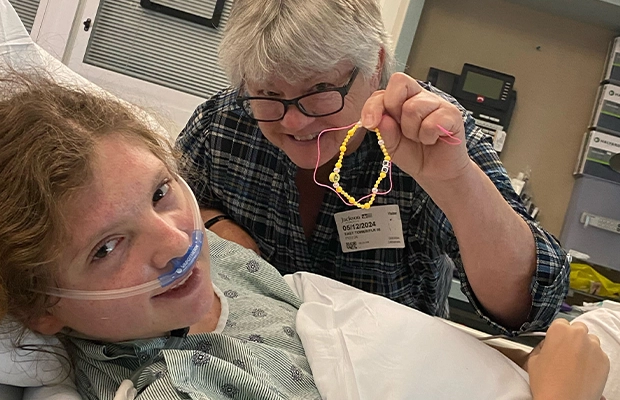
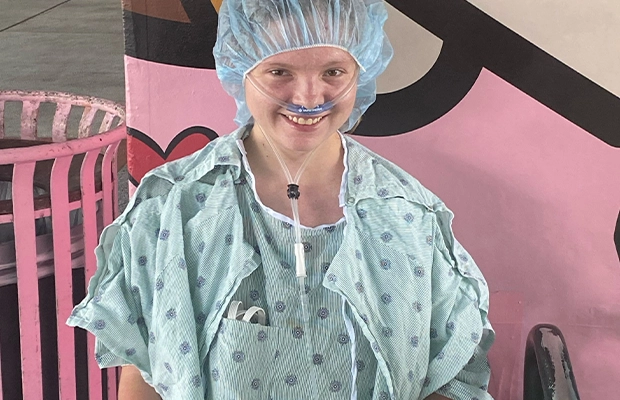
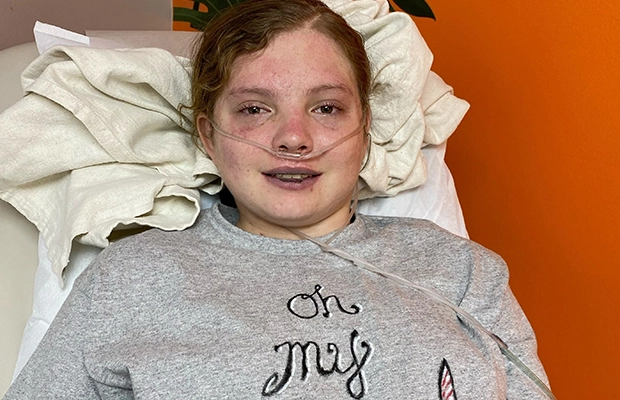
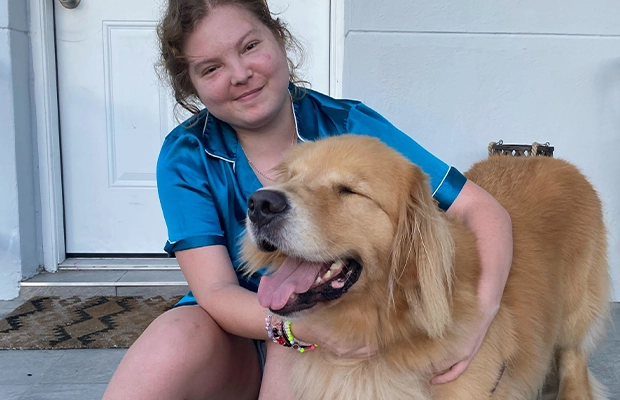
By: Miranda Torres
When Brianna Denny was 11 years old, she was diagnosed with a blood factor deficiency, a rare bleeding disorder where clotting proteins in the blood are missing, low, or don’t work well. Until this point, she was a normal, healthy kid who enjoyed softball, spending time with her friends and family, and going to school.
In February, Brianna, now 15, broke out in a rash on her feet. When it began to spread to her legs and became painful to the touch, she and her family knew something was wrong. A visit to a local children’s hospital led her to a rheumatologist, who began running tests to identify the cause of the rash.
About a month later, the rash returned and went further up Brianna’s leg. A hematologist recommended she be transported to Holtz Children’s Hospital.
While at Holtz Children’s, it was discovered that Brianna had autoimmune hepatitis, a rare, chronic liver disease that occurs when the body’s immune system attacks the liver, and hepatopulmonary syndrome, a rare lung complication connected to liver disease. Due to these conditions, she was experiencing stage three cirrhosis of the liver, a condition that can only be treated with a liver transplant.
Her hepatopulmonary disease meant that Brianna required oxygen for over a month while the team at Holtz children’s focused on her liver.
Brianna was immediately placed under the care of the pediatric transplant team at the Miami Transplant Institute (MTI), which included Gennaro Selvaggi, MD, transplant surgeon, Jennifer Garcia, MD, medical director of pediatric transplant services, adult and pediatric intestinal rehabilitation, and intestinal transplant, Akin Tekin, MD, liver, intestinal, and multivisceral surgeon, and Jessica Hochberg, MD, pediatric gastroenterologist at Holtz Children’s Hospital.
Brianna was listed for a transplant on April 17, and just seven days later, received the call that a liver had been found. On April 25, Dr. Selvaggi and his team transplanted Brianna and gave her a second chance at life.
While it was initially expected that Brianna could potentially require oxygen for at least a year post-transplant, she is off oxygen and recovering back home in Lake Placid. “She is determined, a fighter, and against all odds wants to get back to her normal life which is think is hugely important in her recovery journey,” says Dr. Hochberg. She also has a great support system in her family.”
She is looking forward to returning to her favorite activities such as softball and spending time with her friends, and school in November.
“Thank you to the team of doctors, nurses, and everyone at the hospital who took care of me,” Brianna said. “My mom gave me the strength to get through this, and so did my friends, who reached out every day.”
Columbus Student and Cross County Star Suffers Massive Brain Bleed, Makes Full Recovery at Jackson
Columbus Student and Cross County Star Suffers Massive Brain Bleed, Makes Full Recovery at Jackson
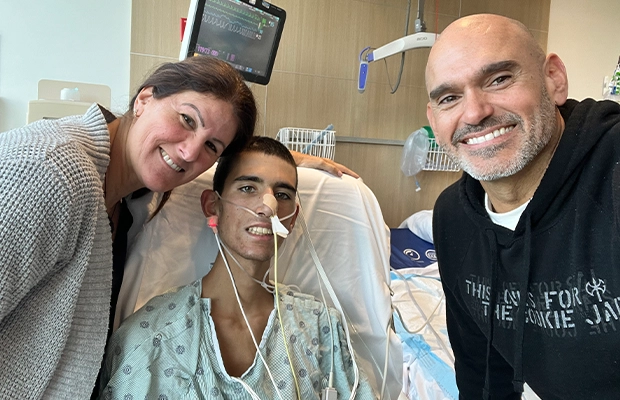
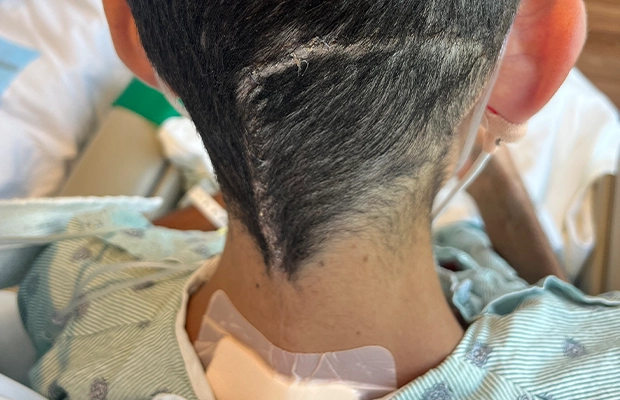
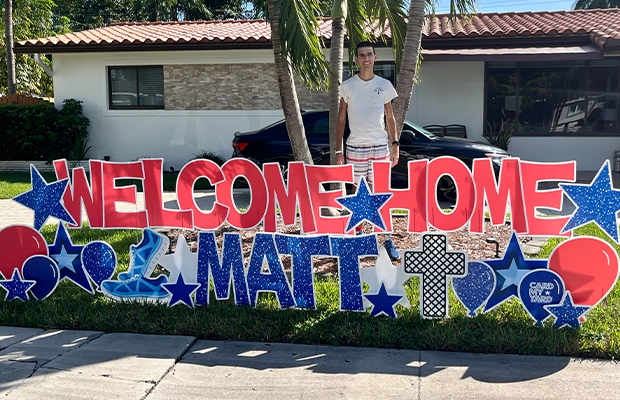
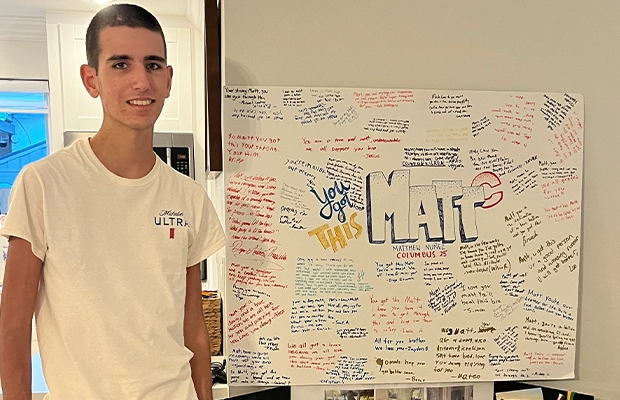
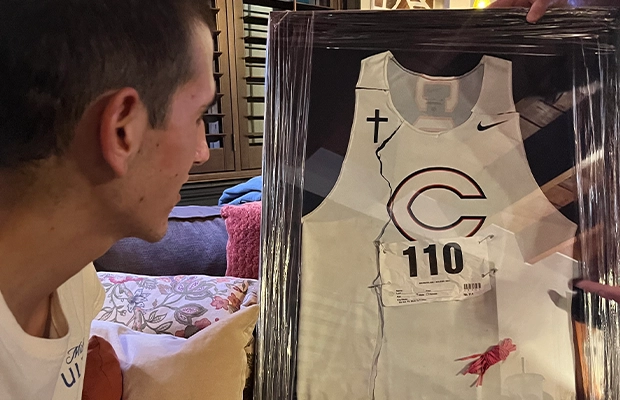
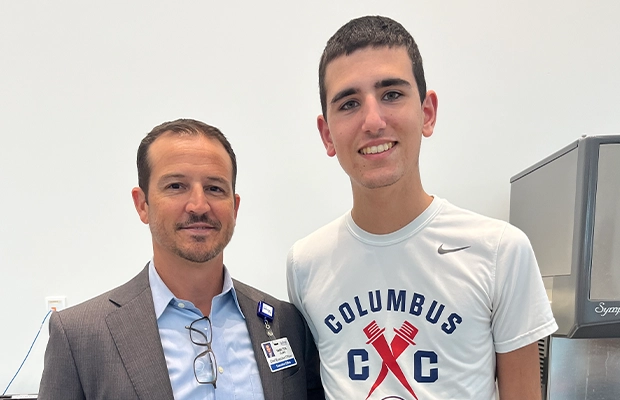
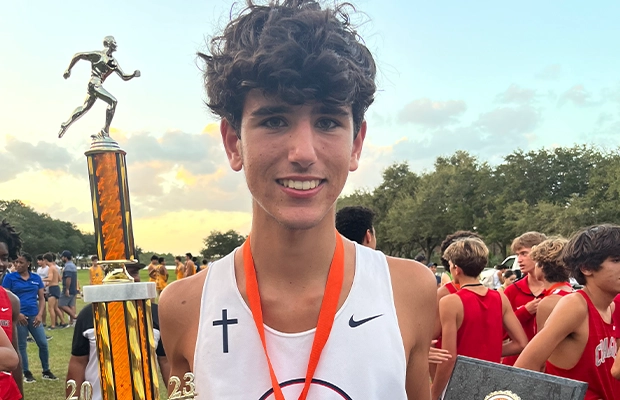
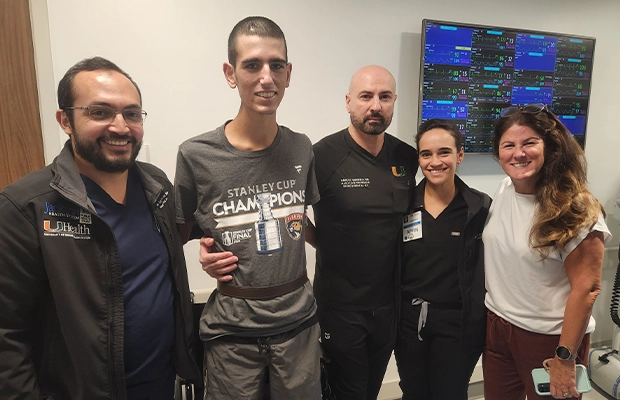
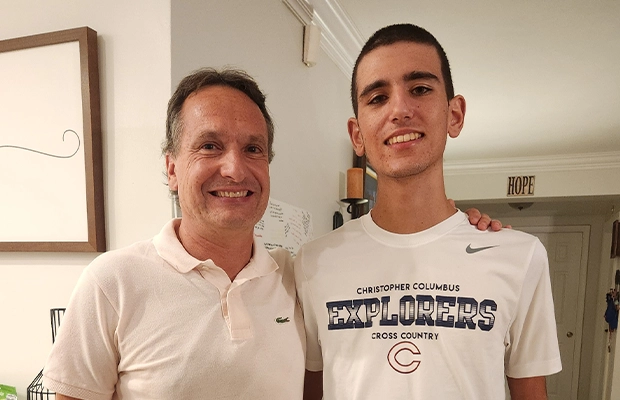
By: Krysten Brenlla
When Matthew Nunez was a freshman at Christopher Columbus Senior High School, he followed his older brother’s footsteps by joining the track and cross-country teams.
For years, the now 18-year-old competed in countless races without any issues. As his senior year approached, Matthew was preparing to run at the collegiate level, backed by his family, friends, and teammates.
“It was really a normal day, a typical race day on a Friday afternoon,” said Matthew’s parents, Anna and Carlos Nunez. “In fact, he was pumped up for the race and ready for it. He had absolutely zero signs of anything.”
On Friday, September 27, 2024, less than half a mile into the race, Matthew started to feel sharp pain on the right side of his head that spread down to his jaw.
“The pain got so bad that I had to turn myself around and walk toward the golf cart that follows the runners,” Matthew said.
At first, the race paramedics thought it was dehydration or heat exhaustion. However, as they started to examine him, they knew something else was wrong.
“I usually wait for him at the two-mile mark, but I noticed that Matthew wasn’t coming,” Anna said. “People began calling me, telling me, ‘Something happened, you have to get back to the rescue at the finish line.’”
Matthew was rushed to Ryder Trauma Center at Jackson South, where a team led by Antonio Marttos, MD, a UHealth – University of Miami Health System trauma surgeon at Ryder Trauma, worked to stabilize and assess him.
“When he arrived at Jackson South, he was in critical condition,” Dr. Marttos said. “What concerned us most was that he was not moving his right side properly. We quickly sent him in for a CT scan to evaluate for a possible brain bleed, but within minutes, at the CT scanner, his heart and lungs began to fail.”
The multidisciplinary care team acted quickly and intubated Matthew, placing him on a ventilator to help him breathe and giving him life-saving medication to help his heart keep adequate blood pressure and blood flow to the brain.
When the CT scan was finally performed, a massive brain bleed was found.
“I was in the chapel at Jackson South when Dr. Marttos gave me the news. It was just utter shock,” Anna said. “So many thoughts started popping into my head. But, Dr. Marttos and his team gave us the confidence we needed, and I knew that they would do everything they could to help our son.”
To control the bleed, Matthew underwent emergency neurosurgery, which lowered the pressure on his brain that was triggering multi-organ failure. Once resuscitated, he was airlifted to Ryder Trauma Center at Jackson Memorial.
At Jackson Memorial, a specialized team of neurosurgeons was ready to take over and address the source of Matthew’s bleeding.
“The initial step was ensuring his heart and lungs were resuscitated,” said Adib Abla, MD, chief of cranial neurosurgery at Jackson Memorial. “Ultimately, we found the cause of bleeding in the brain was a vascular lesion located in the brainstem, which is an abnormality in the brain’s blood vessels that can burst, resulting in a dangerous brain bleed.”
On October 4, Dr. Abla and his team performed a successful surgery that removed the entire lesion.
After surgery, Matthew spent 26 days in the intensive care unit, and 11 days at Christine E. Lynn Rehabilitation Center for The Miami Project to Cure Paralysis at UHealth/Jackson Memorial.
“Everybody here made those days as smooth and comfortable as could be considering the situation – they made us feel at home,” Carlos said. “I knew that Matthew was going to be okay because he was in the best place possible to recover from this. It is an absolute miracle.”
Today, Matthew has made a full recovery, and has returned to what he loves the most – running. He’s looking forward to finishing his senior year, and hopes to continue his running career in college.
“To the entire team at Jackson, there are no words that can truly express my gratitude,’” he said. “They saved my life.”
South Florida Man with End-Stage Lung Disease Saved with Double-Lung Transplant at Miami Transplant Institute
South Florida Man with End-Stage Lung Disease Saved with Double-Lung Transplant at Miami Transplant Institute
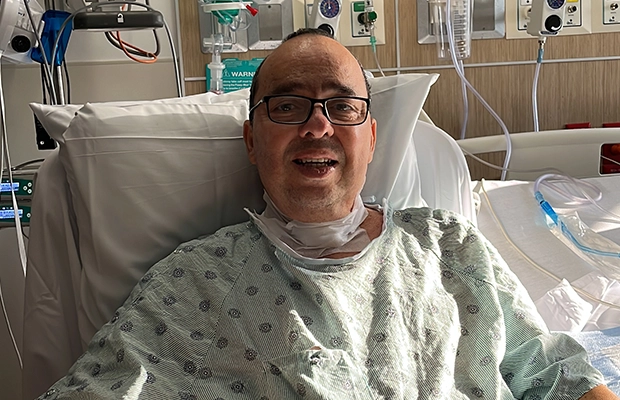
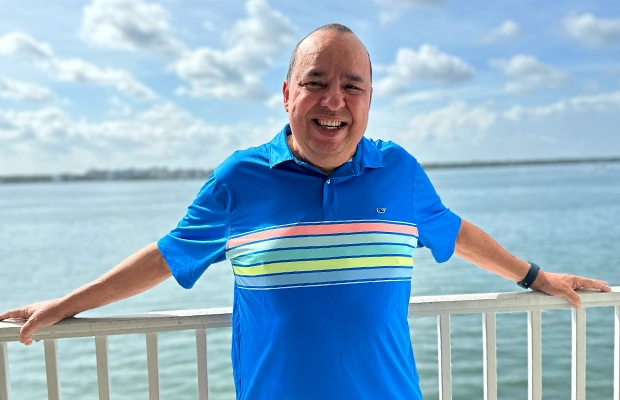
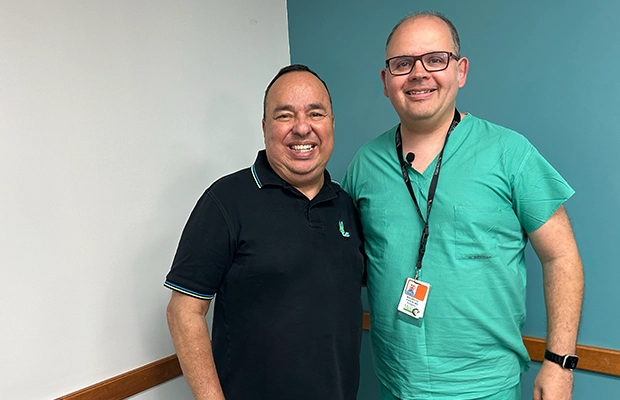
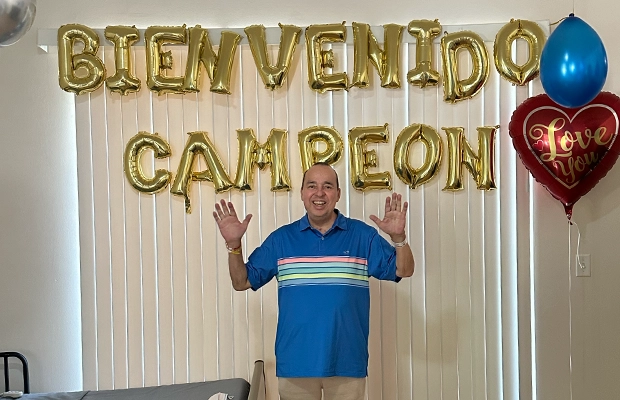
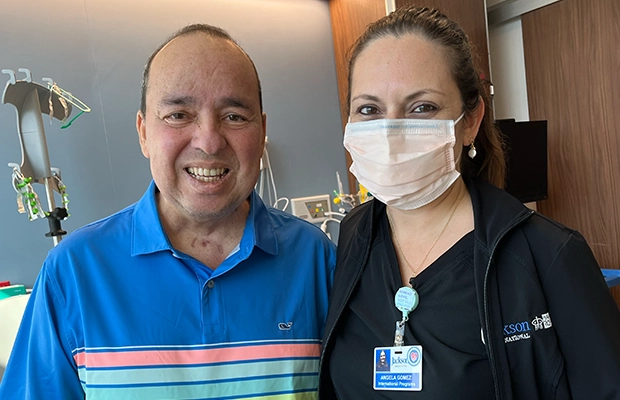
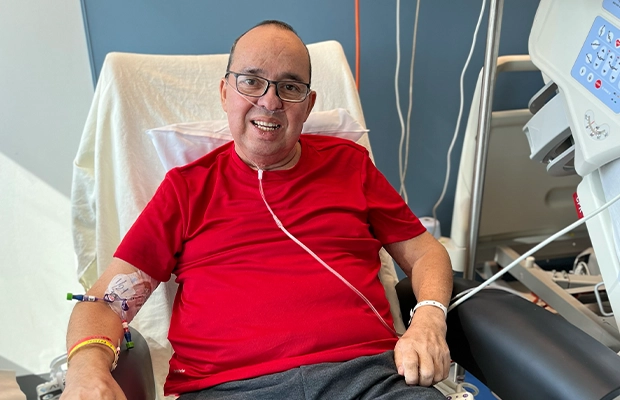
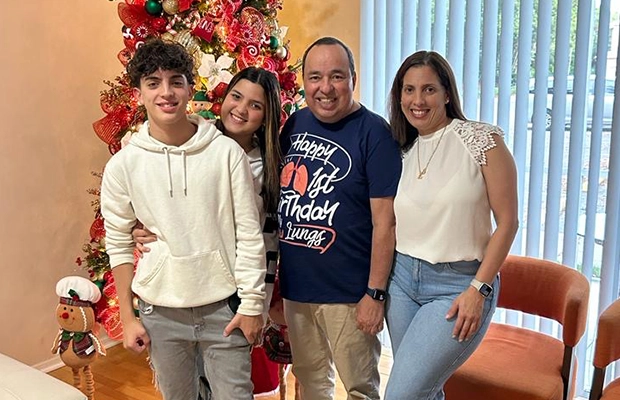
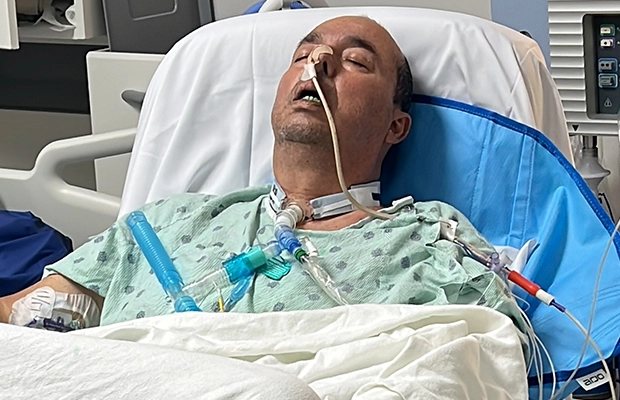
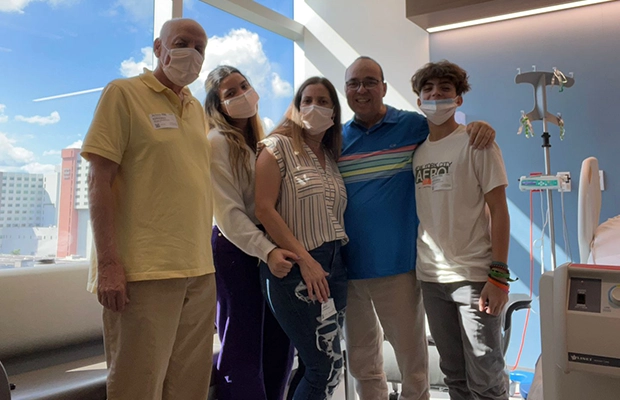
By: Krysten Brenlla
A Venezuelan native, Orlando Guerra, 61, moved to the United States in November 2019 to provide a better opportunity for his family.
In January 2021, Guerra contracted COVID-19, but recovered without needing any medical intervention.
However, as the months passed, he began to suffer from shortness of breath, persistent coughing, and fatigue. In April 2021, Guerra consulted his primary care doctor, who gave him devastating news: he was diagnosed with post-COVID pulmonary fibrosis, a chronic condition that causes gradual scarring of the lungs.
“After my diagnosis, I started treatments to help stop the progression of the disease. But it just reached a point where my lungs weren’t able to function anymore because my oxygen levels were so low,” Guerra said. “My doctor told me that transplant was the only option I had left.”
He was referred to the Miami Transplant Institute (MTI), an affiliation between Jackson Health System and UHealth – University of Miami Health System, where he met his new team of pulmonologists and lung experts at The Lung Center at Jackson and MTI.
“When we first saw Orlando, he was suffering from end-stage lung disease and was depending on a lot of oxygen. He was also overweight, so we worked with him to help him lose the weight so he could be eligible for transplantation,” said Juan Salgado, MD, fellowship director for transplant pulmonology at The Lung Center at Jackson and MTI.
“His odds at surviving the next six months were very slim.”
Guerra’s post-COVID fibrosis continued to deteriorate. However, with the help of therapy at Christine E. Lynn Rehabilitation Center for The Miami Project to Cure Paralysis at UHealth/Jackson Memorial and the multi-disciplinary care at The Lung Center, he lost the weight and became eligible for transplantation.
After just one week of being listed for a transplant, he received the call he longed for: a match was found.
“My world turned upside down – I felt terror and happiness at the same time,” Guerra said. “I called my wife, who was at work, and I talked to my kids before leaving – I was full of enthusiasm because when that moment came, I knew I would keep living and would be able to spend more time with my family, which is the most important thing for me.”
On November 4, 2022, the team at The Lung Center successfully performed Guerra’s double-lung transplant.
After the procedure, he spent three months in the hospital recovering, while undergoing more rehabilitation therapy to help him with daily activities.
By March 4, 2022, Guerra was healthy and ready to go home.
“Orlando has made remarkable progress and no longer requires supplemental oxygen or therapy; he’s living a normal life,” Dr. Salgado said. “Our daily work is a collaborative effort involving a large, multi-disciplinary team that helps us navigate the challenges of our complex cases, allowing us to restore quality of life for our patients.”
Today, Guerra is embracing life as he once knew it. He’s also collaborating with local producers on a documentary to share his transplant journey, hoping to inspire others to remain strong in their battle against end-stage lung disease while advocating for organ transplantation.
“I’m so grateful for God, for the doctors at MTI, and for the donor family – I’m alive today because of them,” Guerra said. “One of the most important things in life is breathing – if you can’t breathe, you can’t live. I thank God every day for this second chance.”
Jackson Employee Suffering from Rare Autoimmune Disease Makes Remarkable Recovery with Help from Rehabilitation Therapy at Jackson North
Jackson Employee Suffering from Rare Autoimmune Disease Makes Remarkable Recovery with Help from Rehabilitation Therapy at Jackson North
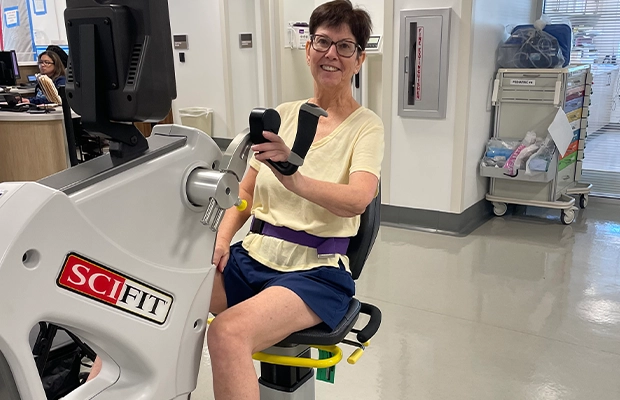
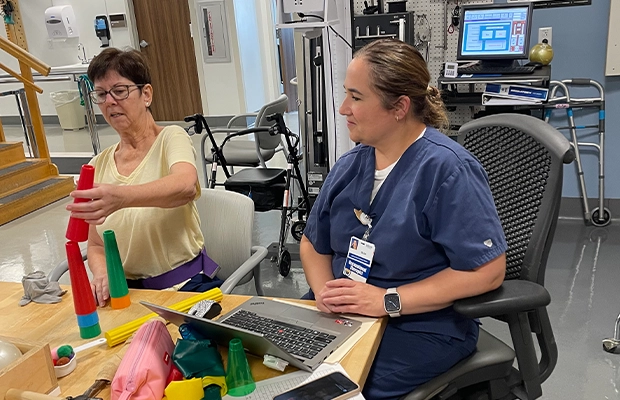
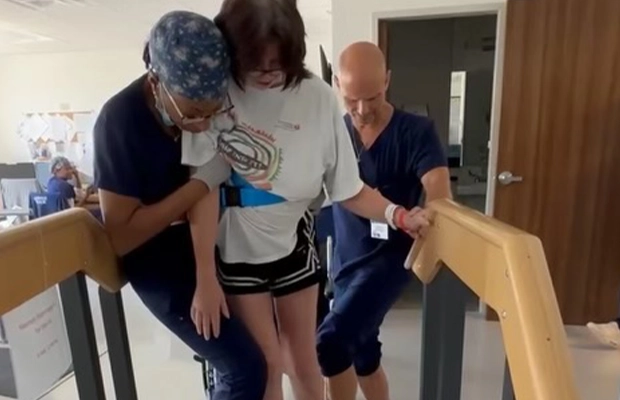
By: Krysten Brenlla
For nearly 20 years, Roma Baczyk worked as the environmental health and safety coordinator at Jackson North Medical Center.
The 65-year-old kept a relatively healthy lifestyle until one day when a case of sinusitis led to paralysis.
“The weekend of March 8, 2024, I went to the urgent care where they prescribed me some antibiotics and a nose spray for sinusitis. The weekend after, I woke up with my fingers numb,” Baczyk said. “I called my sister and told her she had to take me to the hospital, because I knew something was not right.”
By the time her sister arrived, both of Baczyk’s hands were numb, including her wrists. Her toes also began to tingle, and her speech was impaired.
She was rushed to a nearby hospital, where the emergency team ran several tests to rule out a stroke. As time passed, her body continued to deteriorate.
“By that night in the hospital, I lost everything – from the neck down, I couldn’t move,” Baczyk said. “I was still able to breathe, but two days later, I was intubated.”
Her medical team discovered that Baczyk was suffering from a rare autoimmune disease called Guillain-Barré syndrome, which occurs when the body’s immune system attacks the nervous system. It often starts with weakness and tingling in the upper or lower extremities, which can spread to other parts of the body.
“I was in the intensive care unit, where I was intubated for eight days before they were able to transfer me for rehabilitation therapy at Jackson North,” Baczyk said. “I couldn’t move my legs or arms or speak at all – I was essentially paralyzed.”
When her therapists and co-workers at Jackson North first assessed her, they were shocked.
“I was surprised to see a woman that I constantly saw moving through the hospital halls, a colleague who was always so full of life, with no functional movement,” said Baltany Michel, an occupational therapist at Jackson North. “She had zero movement in her upper extremities, and showed slight muscle contractions in her lower extremities.”
When Baczyk first started her occupational and physical therapy sessions, she couldn’t hold her head up or sit upright.
“To even communicate with us and her nurses, she had to use a sip-and-puff device, which allowed her to blow into a tube to signal for help since her hands couldn’t function to press the call bell,” Michel said.
However, as time progressed, Baczyk slowly improved with targeted exercises in physical, occupational, speech, and recreational therapy to help with her function and mobility.
Her team also focused on neurological exercises to retrain the brain to send signals to her muscles, helping her regain voluntary control over her body, which had the most significant impact on her recovery.
After more than 100 days of hard work, Baczyk went from being entirely dependent to walking and climbing stairs on her own.
“My biggest goal was to be able to walk out of there,” she said. “Everyone at Jackson North was so creative, and with their help, I was able to reach major milestones.”
Today, Baczyk is back home and has regained much of her function in both her lower and upper extremities.
“I’m walking now and am able to move around by myself – although not gracefully – thanks to them,” she said.
Baczyk continues to work with her therapists at Jackson North to improve her fine motor skills and things like brushing her own teeth, combing her hair, pulling her clothes up, and feeding herself.
“Roma’s story serves as a powerful example of determination, teamwork, and the potential of intense therapy,” Michel said. “Her resilience inspired not only her, but all of us at Jackson North.”
“I can’t rave enough about the Jackson North rehabilitation team,” Baczyk said. “They are passionate, compassionate, creative, and care for each and every patient. They were a godsend.”
Teenager Given Second Chance at Life Following Traumatic ATV Accident
Teenager Given Second Chance at Life Following Traumatic ATV Accident
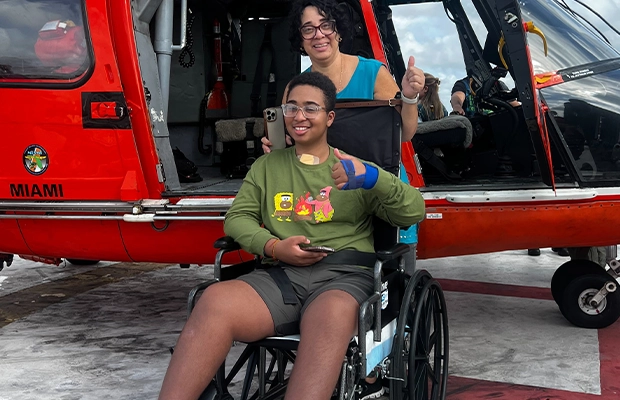
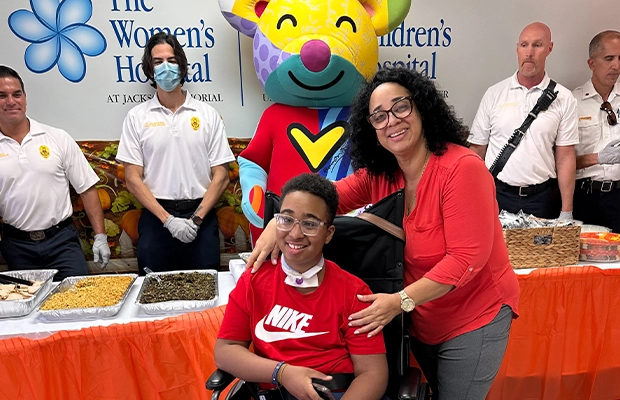
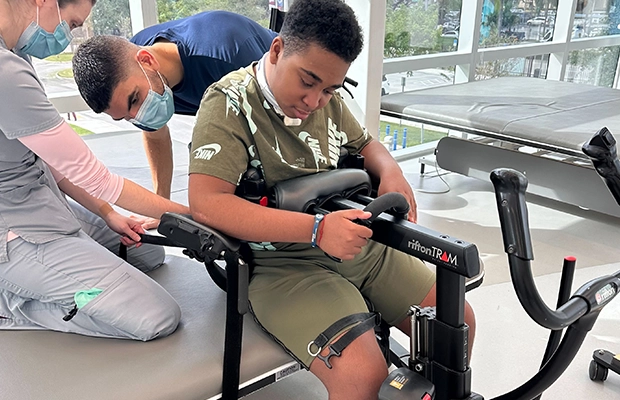
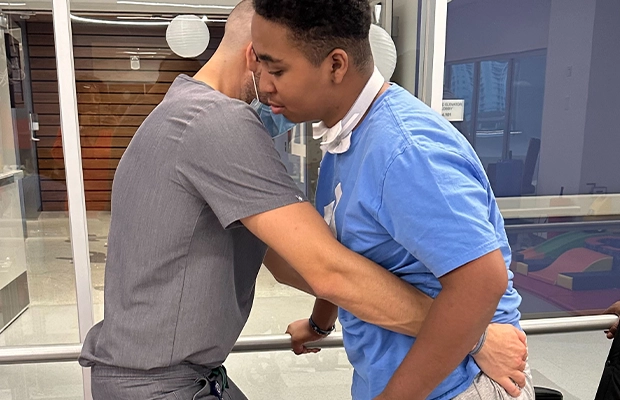
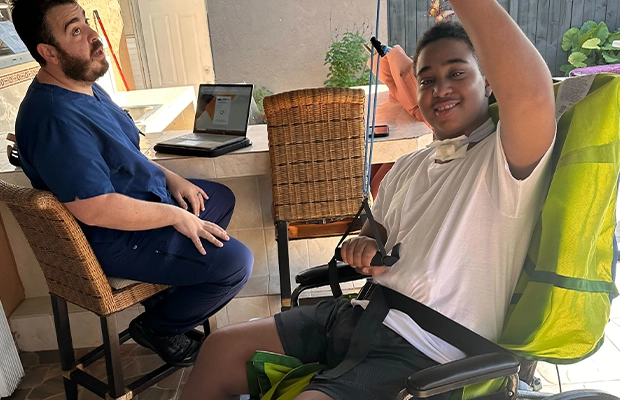
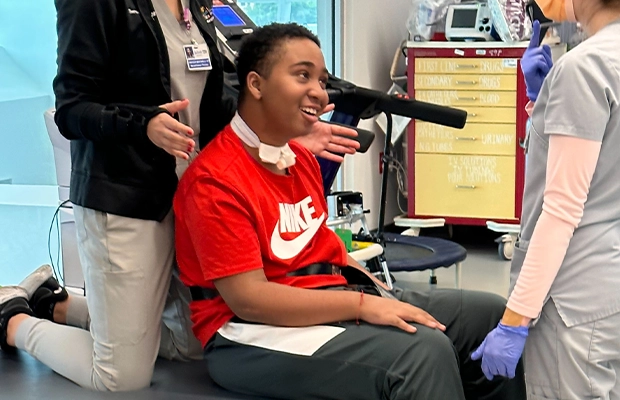
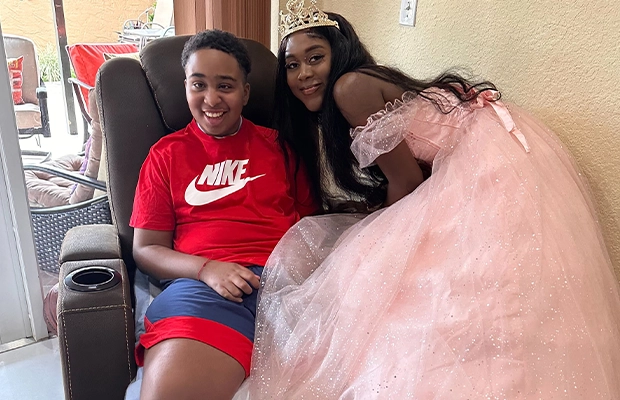
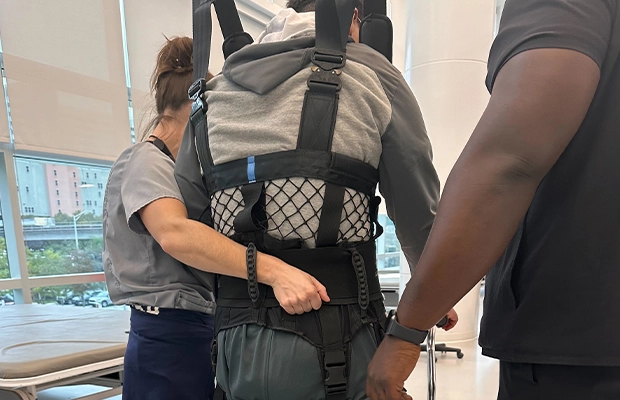
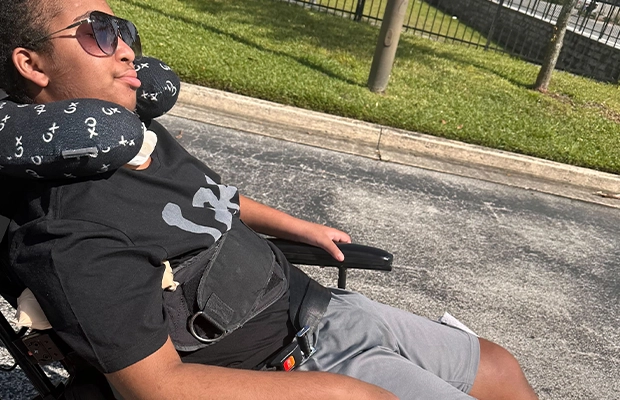
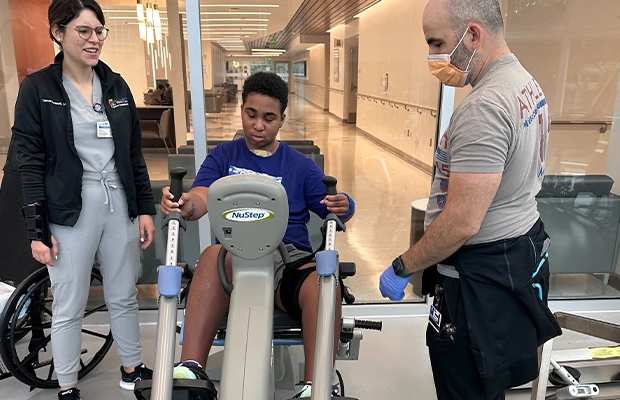
By: Miranda Torres
Kevin Valdez, 15, was riding ATVs with his friends on July 9, 2023 when his life changed forever. Despite being warned not to ride the four-wheeler and to avoid driving on main roads, Kevin drove off without informing his loved ones. In the middle of the ride, he was caught off guard by an object ahead of him, and slammed his breaks to avoid running it over. The force from the abrupt stop launched him 50 feet. His Life360 app alerted his mom of a crash, which is how he was found.
“All of Kevin’s friends were older than him and had their licenses, but he was only 14 and had never driven on the streets with cars before, which is why I didn’t want him riding the ATV that day,” said Ileana Matos, Kevin’s mom. “It all happened so fast, I couldn’t wrap my head around what was happening.”
Kevin was rushed to Ryder Trauma Center at Jackson South, but was then airlifted to Ryder Trauma Center at Jackson Memorial due to the severity of his injuries, which included a traumatic brain injury (TBI), brain swelling, and a broken femur.
“I remember being in such shock that I raced to Ryder Trauma to meet the helicopter. We got there so fast that I watched the helicopter land knowing my son was inside,” Matos said. “That was the last time I was behind the wheel of a car since.”
Because of the TBI, Kevin was in a coma for more than a month and temporarily paralyzed on his left side. Heather McCrea, MD, PhD, director of pediatric neurosurgery at Holtz Children’s Hospital, and a UHealth – University of Miami Health System pediatric neurosurgeon, and the pediatric neurosurgery team placed a pressure monitor to optimize medical management and reduce his intracranial pressure, which would be key to preventing further brain injury.
Kevin’s brain pressure wasn’t stable enough to undergo the orthopedic surgery needed to correct his broken femur until three weeks post-accident. Brian Black, MD, a pediatric orthopedic surgeon at Holtz Children’s, was able to operate on the fracture via a small incision in the hip. After having his broken femur corrected, Kevin was able to bear weight on his leg again, which allowed him to start inpatient rehabilitation care.
After being discharged from Holtz Children’s in September 2023, he was admitted to an inpatient facility in Jacksonville, FL that catered to pediatric rehabilitation patients with more serious cognitive deficits. While there, Matos was dedicated to getting Kevin to “emerge” – a term used in the rehabilitation field that signifies a person has regained their ability to interact, be alert, and be aware of their surroundings by responding and voluntarily participating in therapies. A month later, Kevin regained consciousness and qualified for acute inpatient rehab therapy at Holtz Children’s.
He began his stay in November 2023, undergoing physical, occupational, and speech therapies six days a week under the guidance of Joslyn Gober, DO, medical director of pediatric rehabilitation medicine at Christine E. Lynn Rehabilitation Center for The Miami Project to Cure Paralysis at UHealth/Jackson Memorial.
When he started his inpatient stay, Kevin was immobile, unable to speak or communicate, and required maximum assistance to perform everyday tasks. Thanks to his family’s support and work with Lynn Rehabilitation Center’s Kyle Zreibe, pediatric physical therapist, Kiara Cespedes, pediatric occupational therapist, and Brenda Coba, pediatric speech therapist, Kevin has improved significantly. He has regained use of his left side and voluntarily does activities with his left hand, can communicate with technologies like tablets and keyboards, and went from exclusively eating via a GI tube to following a mechanical soft diet and feeding himself.
“Ileana is a great advocate for her child. She is top notch when it comes to advocating and asking the right questions,” said Zreibe and Cespedes. “She really pushed to get him whatever he needed, and she definitely deserves a lot of the credit for his improvement.”
Kevin was discharged from Holtz Children’s in December 2023, and has continued to receive outpatient therapy with his team at Lynn Rehabilitation Center.
“I owe my son’s life to the team at Jackson,” Matos said. “I will never tire of thanking them for being so insistent with his care and saving his life. I have no words to thank the therapists at Lynn Rehabilitation Center and care teams at Holtz Children’s for everything they’ve done.”